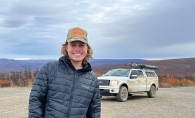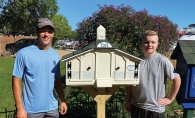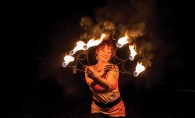
According to landscape architect Bruce Lemke, every one of his own nature-based sculptures begins with a story that he creates for himself to get his creative juices flowing.
Take, for example, the Orono resident’s whimsical upside-down tree house, which was part of the “Amazing Spaces, Places and Escapes: Re-imagining Treehouses” exhibition at the Minnesota Landscape Arboretum from May through September. He knew he wanted to offer “a different take on a treehouse” as a starting point for the commissioned project, his fifth at the arboretum, so he created a fictional backstory about friend and fellow landscape architect James Rand, who played a joke on Lemke, all in good fun, about 10 years ago. In the spirit of returning the favor, the story of the upside-down house became the tale of an architect “who could never get it right” when it came to building a treehouse—to the point of reading his detailed plans upside down, hence the structure of the building.
Once the story was created, Lemke says the challenge became, “How am I going to build this thing?” The panels were constructed in his basement in approximately three weeks, then moved by truck to the arboretum. From there came the real challenge: Lemke is afraid of heights. “The house was about 115 feet off the ground, so I was pretty committed to that scaffolding,” he says.
The result was a delightful display that Minnesota Landscape Arboretum director Peter Moe calls “a visitor favorite.” According to Moe, “the ‘loose’ but brilliant construction allowed views into the structure that brought big smiles and lots of photo opportunities.”
Lemke’s day job also allows him to create natural and whimsical structures on a much larger scale, as project manager at Plantscape in Eden Prairie, where he has worked for the past 29 years. At the company’s extensive warehouse, skilled craftspeople build intricate, hand-sculpted artificial trees, shrubbery, and more that become part of the landscape in several Disney and Universal theme parks, as well as at SeaWorld. Although Plantscape also creates these nature-based sculptures for other local sites like the Minneapolis Convention Center, Lemke says the majority of their projects now become the background for the illusions and magical scenes experienced by national and international theme park guests.
One Plantscape project involved building trees for the Frozen Ever After ride at Epcot in Disney World. As one might imagine, the designers for Disney are extremely particular about the look they want to achieve with every detail, interior and exterior, of the theme park attractions. In the case of Frozen Ever After, Lemke says the challenge was to get “just the right amount of snow” on the trees, which involved a lot of back-and-forth with Disney to achieve the proper look.
Imagine Lemke’s surprise when he visited Disney World (one of approximately 10 visits he’s made over the years) and, while on the Frozen ride, realized the cars were traveling so fast, in a darkened atmosphere, “that you couldn’t even see the trees.” Although Lemke and others invested “a lot of time and energy” in the project, he says with a laugh, “Everything has to be perfect, even if it doesn’t matter.” He praises Disney staffers, saying that even though they can be demanding, “they are so much fun to work with.” (And yes, Lemke admits he watched the movie Frozen “quite a few times” during the creation process).
The sculptures are built from the ground up in the Eden Prairie warehouse; the Plantscape staff of approximately 40 workers construct the products using manufactured foliage shipped from China, attached to a steel framework and finished with tough epoxy for authenticity and durability—the sculptures are also flame-retardant. There’s even a product used to produce a sheen on the finished sculptures, which also adds efficiency. “Dust actually falls off, so they really only have to be dusted every six months to a year,” says Lemke. Each sculpted piece generally takes about four or five days to complete. “We can make just about anything here,” he adds.
With projects such as a new Universal theme park, slated to open in Beijing in two years, currently keeping him busy, Lemke hopes to make time for other personal projects at places like the Minnesota Landscape Arboretum. (Another one of Lemke’s projects for the arboretum, which he created in 2009, was the Iris Pond Monster, a less-than-menacing dragon-like creature, which is now put on display every year at Halloween.)
“It’s kind of refreshing to have projects that don’t have the structure I have to follow for Disney,” says Lemke. “You can let yourself go.” Yes, Lemke probably did watch Frozen more than a few times.









